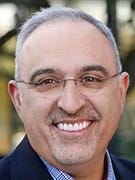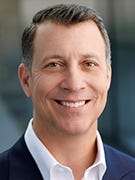HPE's Neri to Partners: 'We See a Future of Opportunity and Growth"HPE's Neri to Partners: 'We See a Future of Opportunity and Growth"
Partners attending HPE Partner Summit hear the vendor increasingly use the word "we" when talking about the vendor-partner relationship.
June 19, 2018

LAS VEGAS — For the more than 2,000 attendees at HPE Partner Summit 2018, being held here in conjunction with HPE Discover 2018, the changed experience of the vendor’s annual partner conference was most evident when Antonio Neri, CEO and president, addressed the audience as the new head honcho. Neri took the reins of HPE in February 2018 when Meg Whitman, former CEO and president, stepped down.

Antonio Neri
Antonio Neri
The new HPE vibe was echoed with the on-stage presence of Paul Hunter, worldwide partner sales leader, new global channel chief, who noted that over 70 percent of HPE revenue is sold through partners.

Paul Hunter
Paul Hunter
“The channel is our fastest-growing route of our business with 18 percent growth in the first quarter,” Hunter said. Noting three acquisitions — Cape Networks, RedPixie and Plexxi — in the last three months, alone, he told attendees, “We’re not shrinking our portfolio, we’re expanding it — giving you more reasons to talk to your customers and prospects about the solutions we can bring.”
Neri, a 20-year-plus company veteran, welcomed partners to the conference hoping they see a refreshed HPE. “We see a future of opportunity and growth,” he said. “HPE is a company that never stops innovating and has a clear understanding of what the future looks like for our customers and partners.”
At the same time, he admitted that there is still work to be done when it comes to engaging with partners. “We know that there’s still a lot of friction in the system, which is why we’re making a significant investment to simplify our company and improve the way we do business with you through our processes and systems,” he said. Neri told partners they will see changes over the next nine quarters.

Phil Davis
Phil Davis
Partners heard Phil Davis, HPE’s chief sales officer, talk about the Super 6, the six key sales opportunities partners should focus on. The Super 6 includes shorter-term (now to two to three years out) opportunities such as Gen 10 transition, blades plus and storage to flash, while the longer term (strategic plays extending now to over the next 10 years) opportunities include everything-as-a-service, software-defined and intelligent edge.
“The Super 6 represents huge transitions we see happening right now in the marketplace,” he said. “The good news about the Super 6 is that we started outside in. We started by looking at the big trends we see customers doing and asking how can we position ourselves to exploit that opportunity, which is a $65 billion plus opportunity?”
Davis homed in on the Super 6 beginning with the short-term opportunities.
The Gen 10 transition market opportunity is valued at $20 billion. HPE, he noted, is well positioned in this market with its industry-standard servers providing partners the opportunity to refresh existing accounts or sell into competitive environments.
“The key is to lead discussions with HPE OneView,” Davis said. “It delivers a differentiated experience for our customers in terms of ease of deployment of infrastructure and automation of routine tasks to take cost out.”
The second transition or short-term opportunity for partners is blades plus. HPE dominates this market with the second place player being Cisco with its Unified Computing System (UCS). Davis took a sharp swipe at Cisco.
“If you look at what’s going on with their investments, it seems like they’re pulling back — you haven’t seen the same pace of innovation from them and it looks like they’re doubling down on security and in other places,” he said. “So, it looks like Cisco isn’t looking to invest in the future.”
Blades plus represents a $6 billion opportunity that’s up for grabs.
Storage to flash is the third short-term opportunity for partners. HPE is well positioned to disrupt this $7.7 billion market, according to Davis, since the company redefined its storage positioning around three key elements: predictive, cloud-ready and timeless.
Looking at the three long-term opportunities, David focused on everything-as-a-service and how public cloud changed the customer’s expectations about how IT should operate. “IT should be scalable and I should only pay for what I use,” he said, noting that 40 percent of IT spend is consumption-based today. Therefore, HPE and partners need to lead with everything-as-a-service and a consumption model such as HPE GreenLake because it’s what customers want.
It’s HPE’s goal to deliver a public cloud experience on-premises for a lower price than a customer can do in the cloud via its software-defined strategy. “You can think of the consumption model and software-defined going hand in hand and it’s the way we’ll enable that cloud-like experience on premises,” Davis said. Again, he pointed to OneView as the conversation starter, SimpliVity for hyperconverged infrastructure, Plexxi, a next-generation network fabric, and OneSphere to integrate from the edge to all a customer’s clouds.
Davis concluded by addressing the intelligent edge, calling it a massively disruptive opportunity to the tune of $26 billion total addressable market (TAM) by 2020. “We see opportunity in every industry around the globe … and we believe that all the edges will be connected via software-defined hybrid cloud environment,” he said.
Cyndi Privett, vice president of research and co-founder of Viewpoint Research, said that HPE’s message on Monday had focus and clarity around strategy and the opportunity that’s on the table for partners today. “In the past, the messaging between compute and storage and Aruba was disconnected, but HPE has brought it together cohesively,” she said.
About the Author
You May Also Like


